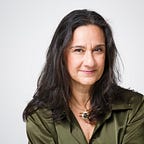The important message of Traditional Medicine Women
For thousands of years, medicine was considered female territory, and every tribe had a medicine woman healer. What can we learn from them about our personal responsibility for our bodies and our health?
“ Nature itself is the best physician” - Hippocrates
Based on Diana Gabledon’s successful novels, the popular television series Outlander tells the story of Claire Randall - an army nurse who travels back and forth in time between the 18th and 20th centuries. During her time travelling, she marries a leader of the Scottish uprising against the British regime and becomes a medicine healer, who in spirit of the Hippocratic oath tends to all in medical need, including enemy soldiers.
Despite her 20th century medical training, Claire does not have access to advanced medicine in her 18th century travels. While relying on modern medicine principles, she trades knowledge with old women, investigates traditional herbs and creates natural healing potions and remedies. Her practice raises suspicion and at times was even perceived as witchcraft, for which she was once nearly executed.
Hunters and Gatherers
Women’s medicine was not fabricated by Gabledon. Throughout history, medicinal plants have served as a major tool mastered by tribal women all over the world, its secrets passed on from generation to generation. Archaeological findings and ancient scribes tell stories of men who hunted and women who tended to the fire, raised children, listened to the sound of the earth, and gathered nature’s gifts for food and healing.
Medicine was considered femimine territory, and every tribe had a medicine woman healer. Her healing secrets and accumulated knowledge on local plants produced a variety of medicines with which she healed the sick, assisted Shamans in ceremonies and traded with other tribes. So, while men adopted linear thinking to hunt, women adopted an integrative approach, in harmony with natural environments and human needs.
From power of knowledge to burning at the stake
In the Middle Ages, whether for religious reasons, political agendas or pure ignorance, the establishment was no longer interested in leaving medicine in the hands of women, and control was turned over to male priests or doctors. For thousands of years, the church hegemony demanded absolute obedience from their followers and preached that the church is their only savior. Threatened by those who otherwise believed in the human’s body ability to heal, tribal medicine was gradually subjected to resistance and contempt, perceived as ‘old wives’ tales’ at best, and as witchcraft at worst. Witch hunting became commonplace and those who were caught using traditional knowledge were sentenced to burn at the stake.
The Revolution of 13 Indigenous Grandmothers
A turning point occurred in the early 2000s when Jeanine (Jyoti) Prevatt, a healer from California, dreams that she meets a woman who hands her a basket. “Inside this basket are some of my most treasured jewels,” said the woman, “they represent lines of prayer that go back to the origin of time. Do not mix them. Do not change them. Protect them and keep them safe. Walk them through the doorway of the millennia, and hand them back to me. I have something we are going to do with them”.
Jyoti later realizes that the jewels in her dream were “grandmothers” — ancient medical healers, and that her mission is to bring them together. Her dream becomes reality when she flies to Africa and meets Bernadette Rabienot, a traditional healer and Shaman, who shared a similar vision. In 2004, backed by the United Nations, they formed the International Council of Thirteen Indigenous Grandmothers. Thirteen traditional medicine women from all over the world gathered in New York to share ancient knowledge, pray, and restore the muchneeded balance between earth, animals, and humans, for the sake of future generations. The council has since been gathering on a regular basis to pray and teach traditional healing practices, while spreading their agenda worldwide.
A whole greater than the sum of its parts
In recent decades, humanity has gradually begun to appreciate the powers of traditional medicine and prayer as important society curers, while realizing that the role of traditional medicine is not to replace Western medicine, but to complete it. While modern medicine is based on the treatment of the problem, traditional medicine is based on the balance between body, mind, environment, and their contexts. A combination of both approaches creates a whole greater than the sum of its parts, as traditional medicine can preserve health, ease pain, and help in cases where modern medicine has no answers.
The comeback of tribal women’s medicine
Today, tribal women’s medicine has returned to the heart of consensus, as health care organizations now provide supplemental natural medical services. However, it is important to remember that the reason for this acknowledgement goes far beyond the boundaries of medicine. It is a call to take back our personal responsibility for the well being of our bodies and souls. This does not mean we should stop addressing medical experts, but rather address our inner knowledge, take the reins, and lead.
Nili Goldfein — EVP Marketing & Business Development at NGG Global Consulting Solutions, specializing in Leadership and Management in a World of Disruption.
